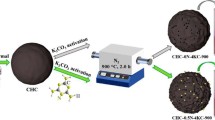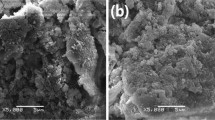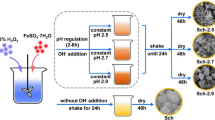Abstract
The recovery of scattered metal ions such as perrhenate (Re(VII)) from industrial effluents has enormous economic benefits and promotes resource reuse. Nanoscale-metal/biochar hybrid biosorbents are attractive for recovery but are limited by their insufficient stability and low selectivity in harsh environments. Herein, a superstable biochar-based biosorbent composed of ZnO nanoparticles with remarkable superhydrophobic features is fabricated, and its adsorption/desorption capabilities toward Re(VII) in strongly acidic aqueous solutions are investigated. The ZnO nanoparticle/biochar hybrid composite (ZBC) exhibits strong acid resistance and high chemical stability, which are attributable to strong C-O-Zn interactions between the biochar and ZnO nanoparticles. Due to the advantages of its hydrolytic stability, superhydrophobicity, and abundance of Zn-O sites, the ZBC proves suitable for the effective and selective separation of Re(VII) from single, binary and multiple ion systems (pH = 1), with a maximum sorption capacity of 29.41 mg/g. More importantly, this material also shows good recyclability and reusability, with high adsorption efficiency after six adsorption-desorption cycles. The findings in this work demonstrate that a metal/biochar hybrid composite is a promising sorbent for Re(VII) separation.

Similar content being viewed by others
References
Abisheva Z S, Zagorodnyaya A N, Bekturganov N S (2011). Review of technologies for rhenium recovery from mineral raw materials in Kazakhstan. Hydrometallurgy, 109(1–2): 1–8
Banerjee D, Kim D, Schweiger M J, Kruger A A, Thallapally P K (2016). Removal of TcO4− ions from solution: Materials and future outlook. Chemical Society Reviews, 45(10): 2724–2739
Boyer Q, Duluard S, Tenailleau C, Ansart F, Turq V, Bonino J P (2017). Functionalized superhydrophobic coatings with micro-nanostructured ZnO particles in a sol-gel matrix. Journal of Materials Science, 52(21): 12677–12688
Cheema H A, Ilyas S, Masud S, Muhsan M A, Mahmood I, Lee J C (2018). Selective recovery of rhenium from molybdenite flue-dust leach liquor using solvent extraction with TBP. Separation and Purification Technology, 191: 116–121
Chen B, Cao Y, Zhao H, Long F, Feng X, Li J, Pan X (2020a). A novel Fe3+-stabilized magnetic polydopamine composite for enhanced selective adsorption and separation of Methylene blue from complex wastewater. Journal of Hazardous Materials, 392: 122263
Chen B, Long F, Chen S, Cao Y, Pan X (2020b). Magnetic chitosan biopolymer as a versatile adsorbent for simultaneous and synergistic removal of different sorts of dyestuffs from simulated wastewater. Chemical Engineering Journal, 385: 123926
Chouchene B, Chaabane T B, Mozet K, Girot E, Corbel S, Balan L, Medjahdi G, Schneider R (2017). Porous Al-doped ZnO rods with selective adsorption properties. Applied Surface Science, 409: 102–110
Du Z, Huang C, Meng J, Yuan Y, Yin Z, Feng L, Liu Y, Zhang L (2020). Sorption of aromatic organophosphate flame retardants on thermally and hydrothermally produced biochars. Frontiers of Environmental Science & Engineering, 14(3): 43
Elkady M F, Ibrahim A M, El-Latif M M A (2011). Assessment of the adsorption kinetics, equilibrium and thermodynamic for the potential removal of reactive red dye using eggshell biocomposite beads. Desalination, 278(1–3): 412–423
Fei J, Luo D, Huang J, Zhang C, Duan X, Zhang L (2018). Growth of aligned ZnO nanorods on carbon fabric and its composite for superior mechanical and tribological performance. Surface and Coatings Technology, 344: 433–440
Gao Y, Chen C, Chen H, Zhang R, Wang X (2015). Synthesis of a novel organic-inorganic hybrid of polyaniline/titanium phosphate for Re (VII) removal. Dalton Transactions (Cambridge, England), 44(19): 8917–8925
Gao Y, Chen K, Tan X, Wang X, Alsaedi A, Hayat T, Chen C (2017). Interaction mechanism of Re(VII) with zirconium dioxide nanoparticles archored onto reduced graphene oxides. ACS Sustainable Chemistry & Engineering, 5(3): 2163–2171
Han D, Li X, Cui Y, Yang X, Chen X, Xu L, Peng J, Li J, Zhai M (2018). Polymeric ionic liquid gels composed of hydrophilic and hydrophobic units for high adsorption selectivity of perrhenate. RSC Advances, 8(17): 9311–9319
Hu C, Mi J, Shang S, Ju S (2014). The study of thermal decomposition kinetics of zinc oxide formation from zinc oxalate dihydrate. Journal of Thermal Analysis and Calorimetry, 115(2): 1119–1125
Hu H, Jiang B, Zhang J, Chen X (2015a). Adsorption of perrhenate ion by bio-char produced from Acidosasa edulis shoot shell in aqueous solution. RSC Advances, 5(127): 104769–104778
Hu X, Ding Z, Zimmerman A R, Wang S, Gao B (2015b). Batch and column sorption of arsenic onto iron-impregnated biochar synthesized through hydrolysis. Water Research, 68: 206–216
Kamali N, Rashidimehrabadi A, Mirabi M, Zahed M A (2021). Synthesis of vinasse-dolomite nanocomposite biochar via a novel developed functionalization method to recover phosphate as a potential fertilizer substitute. Frontiers of Environmental Science & Engineering, 14(4): 70
Li Y, Wang Q, Qi L, Zhang Z, Lei Z, Liu X (2015). Simultaneous speciation of inorganic rhenium and molybdenum in the industrial wastewater by amino-functionalized nano-SiO2. Journal of the Taiwan Institute of Chemical Engineers, 55: 126–132
Ling L L, Liu W J, Zhang S, Jiang H (2017). Magnesium oxide embedded nitrogen self-doped biochar composites: fast and high-efficiency adsorption of heavy metals in an aqueous solution. Environmental Science & Technology, 51(17): 10081–10089
Mishra D K, Mohapatra J, Sharma M K, Chattarjee R, Singh S K, Varma S, Behera S N, Nayak S K, Entel P (2013). Carbon doped ZnO: Synthesis, characterization and interpretation. Journal of Magnetism and Magnetic Materials, 329: 146–152
Pruna A, Wu Z, Zapien J A, Li Y Y, Ruotolo A (2018). Enhanced photocatalytic performance of ZnO nanostructures by electrochemical hybridization with graphene oxide. Applied Surface Science, 441: 936–944
Punnoose A, Dodge K, Rasmussen J W, Chess J, Wingett D, Anders C (2014). Cytotoxicity of ZnO nanoparticles can be tailored by modifying their surface structure: A green chemistry approach for safer nanomaterials. ACS Sustainable Chemistry & Engineering, 2 (7): 1666–1673
Satimova A, Zuo J E, Liu F, Wang Y, Wang S, Verichev K (2020). Ammonia and phosphorus removal from agricultural runoff using cash crop waste-derived biochars. Frontiers of Environmental Science & Engineering, 14(3): 48
Shan W, Fang D, Zhao Z, Shuang Y, Ning L, Xing Z, Xiong Y (2012a). Application of orange peel for adsorption separation of molybdenum (VI) from Re-containing industrial effluent. Biomass and Bioenergy, 37: 289–297
Shan W, Zhang D, Wang X, Wang D, Xing Z, Xiong Y, Fan Y, Yang Y (2019). One-pot synthesis of mesoporous chitosan-silica composite from sodium silicate for application in Rhenium(VII) adsorption. Microporous and Mesoporous Materials, 278: 44–53
Shan W J, Fang D W, Shuang Y, Kong Y X, Zhao Z Y, Xing Z Q, Biswas B K, Xiong Y (2012b). Equilibrium, kinetics, and thermodynamics studies on the recovery of Rhenium(VII) and Molybdenum(VI) from industrial wastewater by chemically modified waste paper gel. Journal of Chemical & Engineering Data, 57(2): 290–297
Su P, Gao X, Zhang J, Djellabi R, Yang B, Wu Q, Wen Z (2021). Enhancing the adsorption function of biochar by mechanochemical graphitization for organic pollutant removal. Frontiers of Environmental Science & Engineering, 15(6): 130
Tan X F, Liu Y G, Gu Y L, Xu Y, Zeng G M, Hu X J, Liu S B, Wang X, Liu S M, Li J (2016). Biochar-based nano-composites for the decontamination of wastewater: A review. Bioresource Technology, 212: 318–333
Virolainen S, Laatikainen M, Sainio T (2015). Ion exchange recovery of rhenium from industrially relevant sulfate solutions: Single column separations and modeling. Hydrometallurgy, 158: 74–82
Wang M C, Sheng G D, Qiu Y P (2015). A novel manganese-oxide/biochar composite for efficient removal of lead(II) from aqueous solutions. International Journal of Environmental Science and Technology, 12(5): 1719–1726
Wang Y, Wang C (2018). Recent advances of rhenium separation and enrichment in China: Industrial processes and laboratory trials. Chinese Chemical Letters, 29(3): 345–352
Wen G, Guo Z (2018). Nonflammable superhydrophobic paper with biomimetic layered structure exhibiting boiling-water resistance and repairable properties for emulsion separation. Journal of Materials Chemistry. A, Materials for Energy and Sustainability, 6(16): 7042–7052
Xue C, Wu J, Wang K, Yi Y, Fang Z, Cheng W, Fang J (2021). Effects of different types of biochar on the properties and reactivity of nano zero-valent iron in soil remediation. Frontiers of Environmental Science & Engineering, 15(5): 101
Zhang B, Liu H Z, Wang W, Gao Z G, Cao Y H (2017). Recovery of rhenium from copper leach solutions using ion exchange with weak base resins. Hydrometallurgy, 173: 50–56
Zhang L, Jiang X Q, Xu T C, Yang L J, Zhang Y Y, Jin H J (2012). Sorption characteristics and separation of Rhenium ions from aqueous solutions using modified nano-Al2O3. Industrial & Engineering Chemistry Research, 51(15): 5577–5584
Author information
Authors and Affiliations
Corresponding author
Additional information
Highlights
• A ZnO-biochar hybrid composite was prepared by solvothermal-pyrolysis synthesis.
• The superhydrophobic composite is suitable for selective recovery of Re(VII).
• The adsorption mechanism is elucidated by experiments and material characterization.
Supporting Information
11783_2021_1456_MOESM1_ESM.pdf
Effective and selective separation of perrhenate from acidic wastewater by super-stable, superhydrophobic, and recyclable biosorbent
Rights and permissions
About this article
Cite this article
Hu, H., Jiang, L., Sun, L. et al. Effective and selective separation of perrhenate from acidic wastewater by super-stable, superhydrophobic, and recyclable biosorbent. Front. Environ. Sci. Eng. 16, 21 (2022). https://doi.org/10.1007/s11783-021-1456-9
Received:
Revised:
Accepted:
Published:
DOI: https://doi.org/10.1007/s11783-021-1456-9




